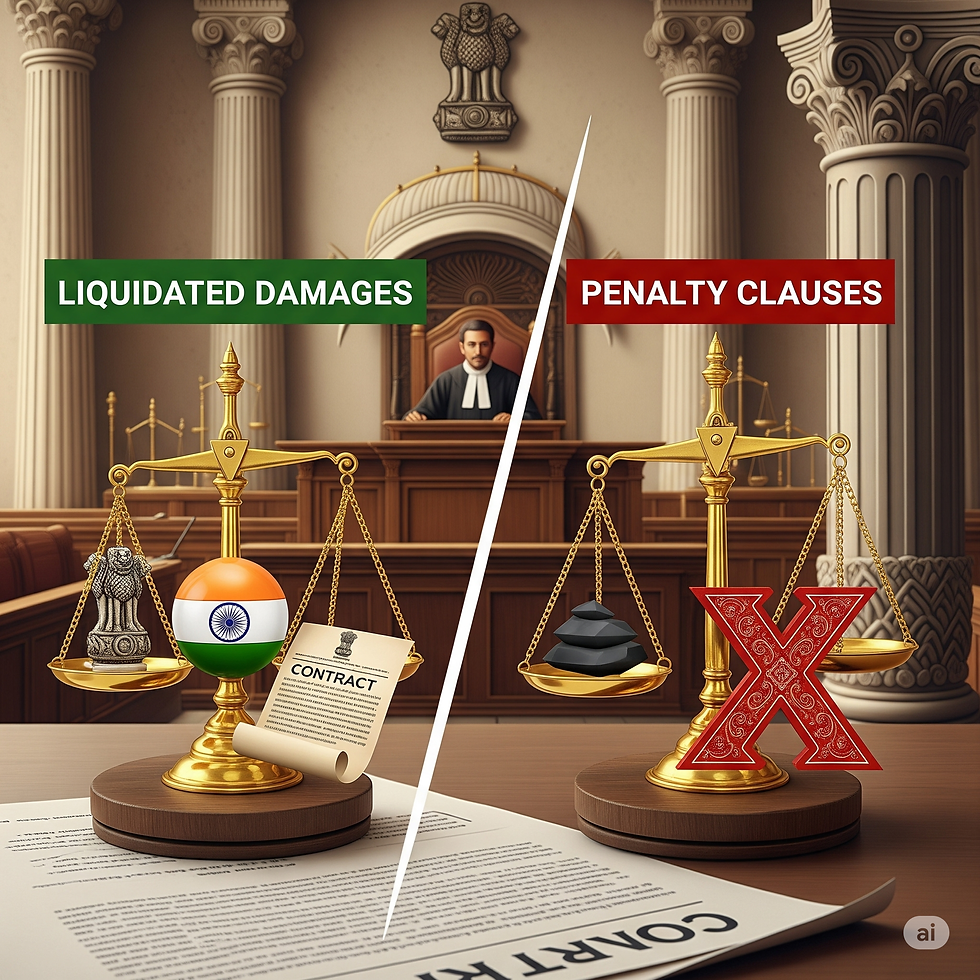Liquidated Damages vs. Penalty Clauses in India
- Legal Amenity

- Jul 16
- 4 min read

Introduction
Contracts form the backbone of commercial transactions. Yet, despite the best intentions, breaches often occur — leading to financial loss and disruption. To safeguard against such risks, parties frequently insert liquidated damages or penalty clauses in their agreements.
While both clauses aim to pre-determine the consequences of a breach, their enforceability under Indian law is distinctly different. This distinction, often misunderstood, carries critical implications for drafting, negotiating, and enforcing contracts.
This article explores the meaning, differences, and legal treatment of liquidated damages and penalty clauses under Indian contract law, along with practical insights and key judicial precedents.
What Are Liquidated Damages?
Liquidated damages refer to a sum agreed upon by the parties at the time of contract formation, representing a genuine pre-estimate of the probable loss arising from a breach.
The purpose is to save time and cost of proving actual loss later. This approach brings certainty to contractual relationships, especially in large commercial deals where quantifying potential loss beforehand is feasible.
What Are Penalty Clauses?
Penalty clauses, on the other hand, are amounts stipulated in the contract that are disproportionate to the anticipated loss, designed primarily to deter breaches or punish the defaulting party.
Under Indian law, penalties are generally not enforceable to their full extent. The courts will usually award reasonable compensation, not exceeding the stipulated sum, and only if loss is proven or reasonably inferred.
Legal Framework Under Indian Contract Act
The Indian Contract Act, 1872, under Section 74, lays down the rule regarding compensation for breach where penalty is stipulated:
“When a contract has been broken, if a sum is named in the contract as the amount to be paid in case of such breach... the party complaining of the breach is entitled... to receive from the party who has broken the contract reasonable compensation not exceeding the amount so named…”
Unlike English law, which distinguishes sharply between liquidated damages (enforceable) and penalties (generally unenforceable), Indian law takes a uniform approach under Section 74. Whether it’s a liquidated damages clause or a penalty clause, the party suffering the breach is entitled only to reasonable compensation, subject to the ceiling set by the contract.
Key Judicial Interpretations in India
Fateh Chand v. Balkishan Das (1963)
In this landmark case, the Supreme Court held that Section 74 dispenses with the need to prove actual loss, but compensation must still be reasonable, and not automatically equivalent to the stipulated sum.
ONGC v. Saw Pipes Ltd. (2003)
The Supreme Court clarified that if the amount named is a genuine pre-estimate of loss, it can be awarded even without detailed proof. However, if it appears to be punitive, courts will reduce it to reasonable compensation.
This judgment is often cited for the principle that courts should examine whether the stipulated sum is a fair estimate of probable loss.
Practical Differences: Liquidated Damages vs. Penalties
Feature | Liquidated Damages | Penalty |
Purpose | Genuine pre-estimate of loss | To deter breach, impose penalty |
Enforceability | Generally upheld if reasonable | Reduced to reasonable compensation |
Need to prove loss | Less stringent; courts often uphold | Courts scrutinize closely, may award less |
Under Indian law | Both governed by Section 74; focus is on “reasonable compensation” not exceeding the amount named |
Practical Tips for Drafting
Use clear language: Clearly state that the amount is a genuine pre-estimate of damages. Avoid using punitive language like “penalty” or “punish”.
Explain the rationale: Document reasons or methods used to arrive at the pre-estimated figure, especially in large projects.
Cap liability carefully: Ensure that the stipulated sum is not excessively disproportionate to potential losses.
Review frequently: As business models evolve, revisit your contracts to ensure damage clauses remain aligned with commercial realities and enforceable under prevailing case law.
Recent Industry Examples
In infrastructure and EPC contracts, liquidated damages clauses for delay in completion are standard. For instance, a clause may specify 0.5% of contract price per week of delay, capped at 10%. Courts usually uphold such provisions if reasonable.
In IT service agreements, parties often stipulate performance-related liquidated damages tied to SLAs (Service Level Agreements). However, if these amounts are exorbitant relative to actual harm, courts may intervene.
Why This Matters for Businesses & Legal Teams
Improperly drafted penalty clauses can undermine risk management objectives. While businesses might be tempted to set high penalty sums to “scare” counterparties into compliance, under Indian law, courts will still only award reasonable compensation.
A well-crafted liquidated damages clause, by contrast, provides predictability, reduces litigation costs, and is more likely to be enforced by courts.
Conclusion
In summary, while parties to a contract have the freedom to stipulate sums payable on breach, Indian courts will ensure such clauses serve a compensatory — not punitive — function. Distinguishing between liquidated damages and penalty clauses is crucial when drafting contracts to protect your commercial interests effectively.
By grounding your clauses in realistic pre-estimates of loss and avoiding punitive intentions, you not only enhance enforceability but also uphold the foundational principle of contracts: to fairly compensate, not punish.
___________________________________________________________________________________
FAQs on Liquidated Damages & Penalty Clauses
1. Are penalty clauses valid under Indian contract law?
Not exactly. Under Section 74, courts award only reasonable compensation, even if the contract sets a penalty amount.
2. How is liquidated damages different from penalty?
Liquidated damages aim to pre-estimate actual loss, while penalties are primarily punitive. Under Indian law, both are subject to the test of “reasonable compensation.”
3. Can I claim the full amount mentioned in my contract’s penalty clause?
Not automatically. The court will award compensation up to that amount only if it’s reasonable and linked to the breach.



Comments